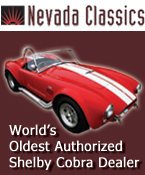
11-25-2010, 08:28 PM
|
 |
CC Member

|
|
|
Join Date: Apr 2005
Location: Tucson,
AZ
Cobra Make, Engine:
Posts: 5,391
|
|

 Not Ranked
Not Ranked
 Original 289/Weber Carb Question
Original 289/Weber Carb Question
Hey all
Back in the day, could you buy an original 289 car with Weber carbs from SA, if you so wanted it that way?
What Weber set up would it have been? (if available)
Larry
__________________
Alba gu brąth
|


